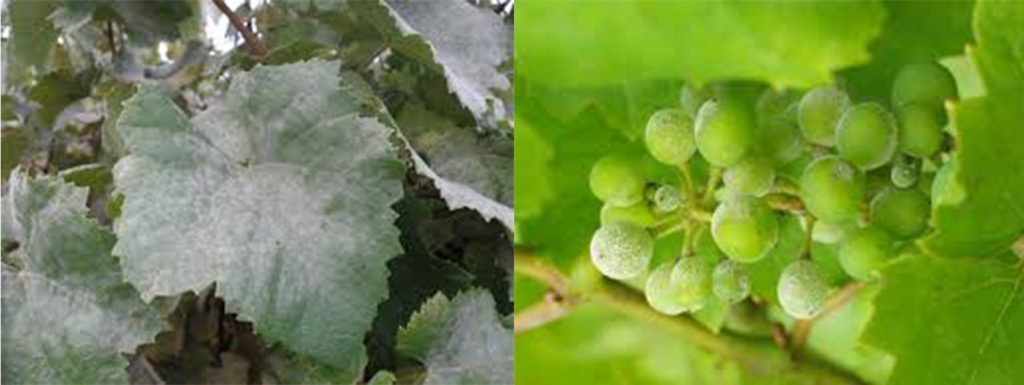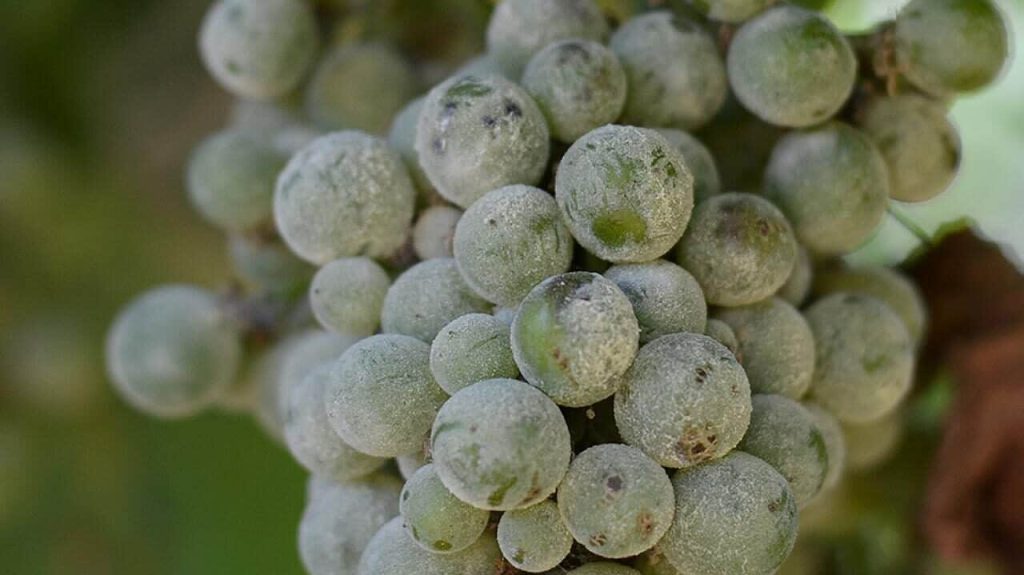Grapes are being planted in most parts of the country. Grapes, especially in the northern and western regions of the country with humid weather, show many diseases such as grape powdery mildew, grape leaf curl, grape gray mold and grape fire. These diseases reduce the quantity and quality of the harvested crop. Be sure to read this article to learn about the types of grape diseases and the best grape fungicides.
Important grapevine diseases
Grapes are one of the most important horticultural crops in the country and one of the most important products in terms of domestic consumption, industry and non-oil exports. Iran ranks ninth in grape production in the world and there is a lot of competition between grape-producing countries. Grapes are a sensitive fruit to various pathogens such as fungi, bacteria, viruses and nematodes.

Grape powdery mildew disease
Powdery mildew, also known as true mildew or surface mildew of grapes, is widely present in most vineyards across the country. The disease appears as white spots on the upper surface of leaves in a floury coating and as white patches on young shoots, which gradually turn brown or black.
The fungal pathogen responsible for the disease is often observed on unripe grape berries, preventing proper ripening, causing them to remain sour, and leading to cracking. The presence of the disease on vines and grape clusters results in both quantitative and qualitative reductions in yield.
Management and control of grape powdery mildew disease
We should establish vineyards in locations with proper air circulation and adequate sunlight. It is better to prune excess and dense branches in early spring. In terms of fertilization, excessive use of nitrogen fertilizers increases the severity of the disease.
To control grape powdery mildew, it is better to remove weeds, especially those growing in the shade under the trees. Some elements, such as sulfur-containing fertilizers, are effective in controlling this disease. Sulfur dust is usually used in dry regions, while wettable sulfur is used in humid areas.
In addition, spraying should be done in three stages:
First stage: Before bud swelling.
Second stage: After petal fall and fruit formation.
Third stage: Two to three weeks after the second spraying, coinciding with the appearance of unripe grapes.
The best fungicides for grape powdery mildew are:
Sulfur fungicide 80% Bahavaran, penconazole fungicide Bahavaran or Topas, Belquit, Strobi

Grape downy mildew disease
Internal powdery mildew or false powdery mildew of grape trees is seen in the regions of Ardabil, Mazandaran, Khuzestan, West and East Azerbaijan.
Yellowish, pale, semi-transparent spots with well-defined margins appear on the upper surface of the leaves, gradually merging, turning brown, and drying out. On the underside of infected leaves, beneath the spots, patches with a soft, grayish-white downy coating can be seen.
This disease can infect young shoots, covering them with white, fuzzy growth, giving them a cane-like appearance. In the early stages, grape clusters are surrounded by a white downy coating. When the unripe grapes reach half of their final size, they become leathery and shriveled.

Management and control of grape downy mildew disease
Planting seedlings in soil with good drainage and sufficient sunlight, collecting diseased parts and burning them at the end of the season to destroy overwintering spores, observing garden ventilation, keeping foliage dry, and eliminating weeds. The best fungicide for grape downy mildew is Captan or Profiler. The best time to spray to combat grape downy mildew: the first time before flowering and the second time 7 to 10 days after the first spraying, in consultation with a plant specialist.
Types of post-harvest diseases of grapes
Postharvest rots of grapes are caused by fungi such as botrytis cinerea, Alternaria spp and penicillium spp. Symptoms of postharvest rot of grape fruit include discoloration, softening, crushing of the berries and their change to gray, brown, blue and green.
Management and control of postharvest diseases in grape fruit
Planting grapes in areas with sufficient sunlight, not using large amounts of nitrogen fertilizers, harvesting grapes on dry days without rain, harvesting clusters using fruit shears, adjusting the temperature of the cold storage between 1 and 4 degrees Celsius and creating ventilation between boxes in the warehouse, using sodium fungicides or sulfur pads, one pad for every 5 kilograms of grape clusters.
Grapevine fanleaf virus (GFLV) is a viral disease that spreads in regions such as Fars, Kurdistan, Zanjan, and Qazvin provinces. This viral disease can affect aerial plant parts, including leaves, shoots, and flowers, appearing as general yellowing, patchy mosaic discoloration between veins, or across the entire leaf.
Young leaves and shoots become deformed, small, and take on a fan-like shape. In some cases, yellow to white borders may appear along the veins, a condition known as vein banding.
Management and control of grape leaf blight viral disease
Using healthy, virus-free rootstocks and selecting seedlings from reputable nurseries, removing infected seedlings and burning them, eliminating nematodes in vineyards, and disinfecting the soil using sodium metam at a rate of 120 to 220 ml per square meter.
Hair curl disease
Grape leaf curl disease is caused by viruses of the genus closterovirus, the most important of which is GLRv3. The virus is distributed in East and West Azerbaijan and Zanjan.
Symptoms of grape leaf curl disease
Growth retardation, downward curling of leaves, smaller size and reduced number of clusters, creating symptoms similar to potassium deficiency symptoms in the leaves.
Disease management and control: Elimination of virus-transmitting pests, use of healthy, certified virus-free rootstocks, removal of diseased seedlings and burning them.
Conclusion: In this article, we learned about the types of grapevine diseases, the causes of grapevine leaf curl, the causes of white spots on grapevine leaves, ways to control them, and the best fungicides for grapevine diseases.



